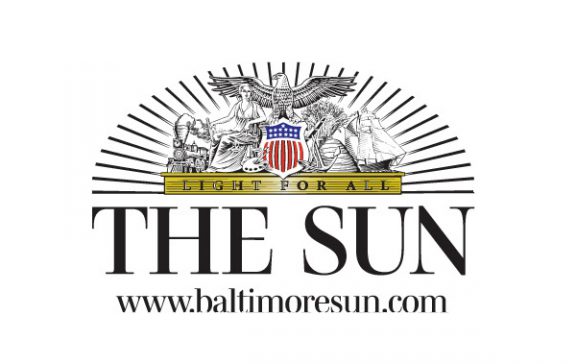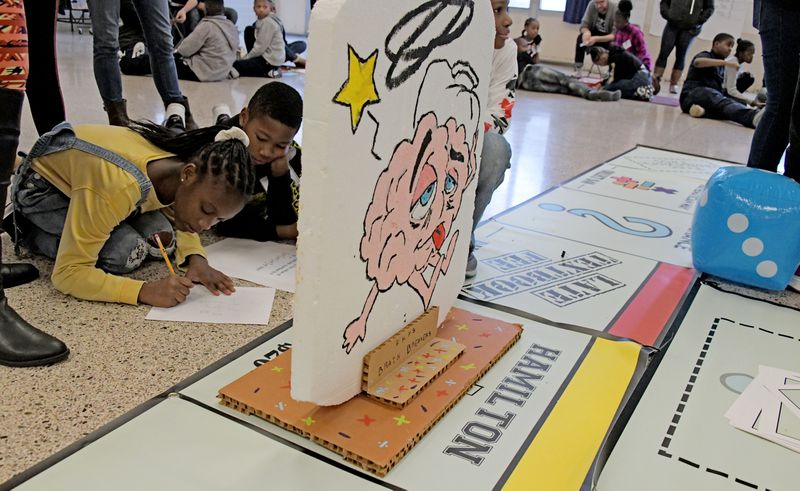Are you smarter than a fifth grade
Baltimore math whiz?
Doubtful, but Poly Mathopoly game day
is fun anyway
DEC 14, 2019
Teams of math-savvy fifth graders from across Baltimore competed in a cafeteria-sized game of arithmetical problem-solving Saturday morning in the city’s citadel of STEM learning, the Baltimore Polytechnic Institute, a high school that many of the boys and girls might one day attend. Sponsored by the Ingenuity Project, the acclaimed science, technology, engineering and math program at Poly, the second annual Mathopoly was a brain challenge for the fifth graders and a way to introduce their parents to opportunities that await the children in sixth grade. Established at Poly in 1997, the Ingenuity Project has expanded to four middle schools — Hamilton, Mount Royal, Roland Park and James McHenry — and many of the fifth graders on the Mathopoly teams have been encouraged to apply to them. “I just learned about that today, and I’m definitely interested,” said Jasmine Swinson, whose daughter, Jaymyla, played on Saturday’s winning team, the Tigers from Mary E. Rodman Elementary School on the west side of the city. “She loves math, she’s an A student.” The Tigers, coached by their teacher, Ruth Sava, scored the most overall points in Mathopoly, a Monopoly-inspired board game created by a middle school teacher from Canada. Instead of Boardwalk and Park Place, contestants might land on Engineer’s Parkway and Game Designer Drive. For the Baltimore competition, Harbor Designs and Manufacturing last year customized a sprawling Mathopoly board covering the cafeteria floor, adding Baltimore middle school names where railroad lines appeared on the original Monopoly board. The students rolled colorful, inflated dice and solved problems to move their Mathopoly pieces — their school team mascots — around the big board. And they faced these challenging questions (answers below): A. “Suppose a standard twelve-hour clock now shows a time of 10:45,” one problem card asked. “What time will the clock show 100 hours from now?” B. Another called for multiple multiplication and division: “What is the value of the following in simplest terms? (20 x 24 x 28 x 32) ÷ (10 x 12 x 14 x 16).” C. Another card demanded an answer to this question: “For every two widgets I buy at the regular price, I can buy a third widget for $4. I bought nine widgets for a total of $90. Find in dollars the regular price of a widget?” D. One of the teams drew this card: “Dr. Bolton was born in an interesting year. The tens digit was twice the thousands digit, the ones digit was three times the tens digit, and the hundreds digit was equal to the sum of the other three digits. In what year was he born?” The fifth graders hurriedly worked out their problems with pencils and paper on the cafeteria floor as their parents watched from the spectator gallery. “It’s great for parents to see their kids competing and focused on math for two hours like this,” said Lisette Morris, the executive director of the Ingenuity Project. “They see their children in a whole different light.” Morris recruited Poly students from the Ingenuity Project to serve as judges for the Mathopoly game and as inspiration for the fifth graders. She introduced two of the Poly seniors because each had just received early acceptance to college: Jarra Omar to Brown University and Matt Arcillo to Johns Hopkins University. “I knew about Ingenuity because they had a [presentation] at Liberty Elementary,” said Rhonda Scott, whose 10-year-old son, Reon, attends that school. “I’m thrilled about it, and we’re going to apply.” Dave McDonald, a 1980 graduate of Poly, came out to watch the Mathopoly game and root for his son Vaughn’s team from Mount Royal Elementary. The team finished second overall. McDonald has an older son in the computer science honors program at Poly, another in an advanced curriculum at Mount Royal and a daughter in second grade at the same school. “They all have math skills,” McDonald said. “You might say we have math in our blood.” He intends to have Vaughn apply for one of the four middle schools where the Ingenuity curriculum is offered. Finishing third in Saturday’s competition were the Brainiacs from Federal Hill Preparatory Academy. The other elementary schools that sent teams were Roland Park, Sinclair Lane, Govans, William Paca, Furman L. Templeton Preparatory Academy, Matthew A. Henson and Gardenville. In all, about 75 students participated. Answers: A. 2:45 B. 16 (2x2x2x2) C. 13 D. 1926
|

